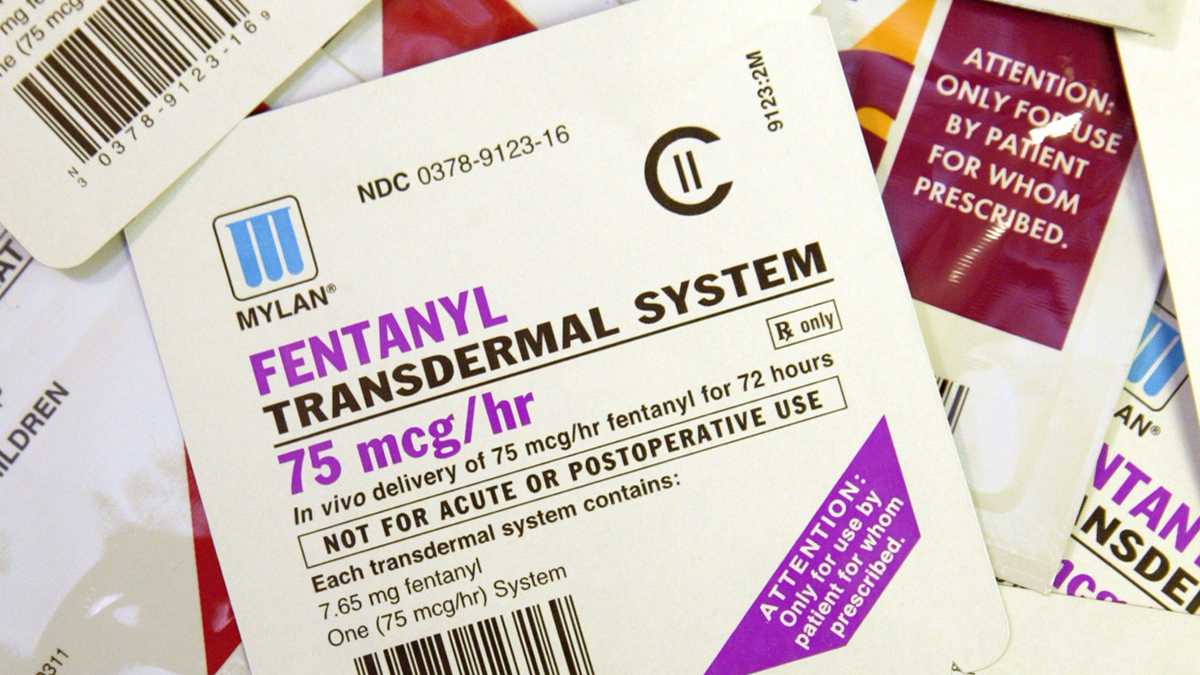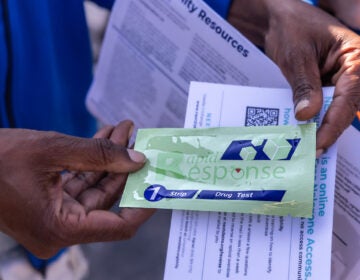Delaware health department warns of dangerous chemical laced in heroin, cocaine

This file photo shows different brands and dosages of Fentanyl patches used to treat end-stage cancer patients. It is considered 80 times more powerful than morphine and can kill by inhibiting breathing. (Tom Gannam/AP Photo)
The health department issued a warning about overdoses related to a chemical added to heroin and other drugs.
Delaware health officials are concerned about a drug more powerful than heroin, which is causing overdose deaths at an increasing rate in the state, and the nation.
Only half way through the year, overdoses from fentanyl, a synthetic painkiller up to 50 times more potent than heroin, already surpasses numbers from last year.
“We urge people to seek treatment for addiction rather than face an increasing risk of death from an overdose of fentanyl, heroin, cocaine or some combination of drugs,” said Secretary Rita Landgraf of Delaware’s Department of Health and Social Services. “With the extreme potency of fentanyl, even one use can be deadly.”
Health experts say fentanyl, which is medically used for end-of-life care and surgeries, affects the central nervous system and brain—and because it’s such a powerful opiate, users often have trouble breathing or can stop breathing as the drug sedates them.
Naloxone, the overdose-reversing medication carried in Delaware by community members, paramedics and some police officers, can be administered for overdoses involving fentanyl. However, health experts say because fentanyl is more potent than heroin or opioid painkillers, multiple doses of naloxone may be needed to reverse an overdose.
“Do we need a stronger lifesaving antidote? Yes, absolutely,” Landgraf said. “But what I would really hope for is we can take care of this before more dangerous substances are getting on our streets and taking our lives.”
Through mid-May there have been 44 overdose deaths involving fentanyl, already an increase over 2015’s 42, according to Delaware’s Division of Forensic Science. The death rates from fentanyl overdose in 2015 are also a dramatic increase from 15 in 2012.
Twenty-four of the cases this year were in New Castle County, while 15 were in Sussex and five were in Kent. The ages of the victims ranged from 17 to 59, with the majority of them between 25 and 35. The largest percentage of the overdose victims were also male.
Overdose rates in general have become alarming in Delaware, with 228 incidents last year, and 222 reported in 2014. Nationwide, the CDC reported 47,055 drug overdose deaths in 2014—1.5 times greater than the number of individuals killed in car crashes.
In 2014, Delaware ranked ninth nationwide, with an overdose rate of 20.9 deaths per 100,000 people, which surpassed the national rate of 14.7 deaths per 100,000 people.
“The popularity of heroin over the past years has had dramatic and fatal consequences, all over the country, particularly in our area,” said Patrick Trainor, special agent and public information officer for U.S. Drug Enforcement Administration in Philadelphia.
“We’ve seen heroin, which is a street drug, is increasingly being cut with fentanyl. It increases the purity of the drug, but the problem is it’s so strong that it’s resulted in numerous overdose deaths in our area.”
Drug dealers sell packets of pure fentanyl in white powder form to clients who often believe they’re purchasing heroin.
“People who have an opiate addiction build up a tolerance to the drug and very often heroin laced with fentanyl, for a lack of a better term, is more attractive to some people who use heroin, so yes, it’s certainly part of a marketing strategy used by drug traffickers in our area,” Trainor said.
They also lace heroin and cocaine with the drug, and press it into pills and sell it as OxyContin, according to the DEA.
“It’s our belief very often street level dealers and people using heroin may not know they’re buying fentanyl,” Trainor said. “All they know is they’re seeking a brand of heroin that’s particularly powerful.”
The Division of Forensic Science confirmed only seven of the 44 overdose cases this year in Delaware had the presence of heroin, and 19 were positive for cocaine. Landgraf said there also is more cocaine on the streets of Delaware, both combined with heroin and laced with fentanyl.
The DEA’s Philadelphia office also warns of a new synthetic opioid, W-18, which it says is 100 times more potent than fentanyl, and is laced into heroin and cocaine and sold in Philadelphia.
Landgraf said it’s a “Chinese research chemical” sold on the internet. She said it’s 10 times more potent than morphine, and is similar to the chemical carfentanil, which has been used for the sedation of large animals like elephants.
It’s difficult for forensic toxicology labs to detect the presence of W-18 in bodily fluid or seized drug samples, according to the DEA.
Landgraf said the health department is concerned about W-18, partly because Delaware has seen a spike in unconfirmed death investigations related to suspected overdoses.
So far in the U.S. there has only been one incident where law enforcement seized the drug, which occurred in Florida in September. Health experts don’t yet know if naloxone can save someone’s life if they have ingested W-18.
The DEA is working with other federal agencies to address the issue, identify the companies and possibly prosecute them when appropriate, Trainor said.
He said the DEA and law enforcement can often trace a drug dealer to an overdose based on the dealer’s “signature stamp” in the drug. The federal government, as well as the state, can charge a person with overdose resulting in death, which has a penalty that starts at 20 years, he said.
The DEA also works on a three-prong approach to tackling drug trafficking, Trainor said, which includes enforcement, partnerships with doctors, the pharmaceutical industry and treatment professionals, and educating the public on the link between opioids and heroin addiction.
“Teenagers are prescribed very powerful opiate drugs after minor surgery procedures like wisdom teeth extractions, and these prescription opiates are very effective at treating pain,” he said.
“However, they’re also very addictive, and the problem is they become addicted to these pills and when the prescription runs out they start to buy these pills in the illicit market. They can spend upwards of $30 or $40 for one pill, and when that money runs out they turn to heroin. Heroin can be purchased for as little as $7 a bag in our area.”
Landgraf said the health department wants to alert the public on the dangers of these chemicals.
“If they are challenged by this disease of addiction we really encourage to first be very careful related to their substance usage, but also to reach out for support for getting into treatment,” she said.
“We want people to know, ‘If you’re unaware of what you’re putting in your body you might want to rethink that usage.’”
She said the health department also is working closer with law enforcement to share information and alert them of any incident. Recently, law enforcement was able to arrest a drug dealer after the health department alerted them to overdose deaths in a specific area, Landgraf said.
DHSS also is updating and expanding a campaign in support of its www.HelpIsHereDE.com website, including seeking additional federal funding and maximizing state funding. The updates will include new resources, information and materials for medical providers and parents.
In the future, she said the health department will set up a comprehensive formalized data sharing system between health officials and law enforcement; encourage the medical community to consider alternatives to opioid prescriptions; increase levels of care and housing for those coming out of treatment; include behavioral health screening in primary care and increase education in schools.
“Through that effort I’m hopeful we can get to the root causes of this, and showing that Delaware is not the place for dealers to come and promote their products,” Landgraf said.
Delaware’s Department of Health and Social Services encourages individuals struggling with addiction to call DHSS’ 24/7 Crisis Services Helpline to be connected to addiction treatment options. In New Castle County the number is 1-800-652-2929. In Kent and Sussex counties the number is 1-800-345-6785.
Individuals and families can visit DHSS’ website, www.HelpIsHereDE.com, for addiction treatment and recovery services in Delaware and nearby states. If individuals see someone overdosing, they should call 911. Under Delaware’s 911/Good Samaritan Law, people who call 911 to report an overdose cannot be prosecuted for low-level drug crimes.
WHYY is your source for fact-based, in-depth journalism and information. As a nonprofit organization, we rely on financial support from readers like you. Please give today.





